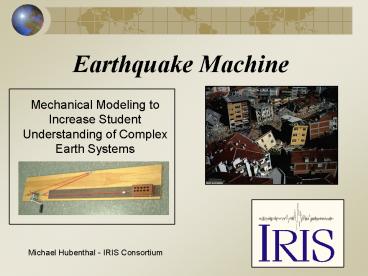Earthquake Machine - PowerPoint PPT Presentation
Title:
Earthquake Machine
Description:
Earthquake Machine Mechanical Modeling to Increase Student Understanding of Complex Earth Systems Michael Hubenthal - IRIS Consortium – PowerPoint PPT presentation
Number of Views:96
Avg rating:3.0/5.0
Title: Earthquake Machine
1
Earthquake Machine
Mechanical Modeling to Increase Student
Understanding of Complex Earth Systems
Michael Hubenthal - IRIS Consortium
2
Objectives (SWBAT)
- Explain earthquakes as a part of the natural
Earth System - Describe global trends for Earthquake occurrence
and magnitude - Interpret a Gutenberg Richter plot (Frequency vs.
Magnitude) - Critically analyze an argument
- Describe the importance of sharing science
results with peers in the science process
3
What is an Earthquake?
Write down a definition for an earthquake
In small groups, discuss your definitions of an
earthquake and create a consensus definition
4
Exploring with a model
5
EQ Machine - Lite
Bulk of the Plate
Top View
C
Elastic Properties of Earth Materials
Plate has Constant Velocity Here
Edge of the Plate
6
What did you observe?
How would you alter your definition, to
accommodate these observations?
7
Elastic Rebound Theory
Distant forces cause a gradual build up of stress
in the earth over tens or hundreds or thousands
of years, slowly distorting the earth underneath
our feet. Eventually, a pre-existing weakness in
the earth--called a fault or a fault zone--can
not resist the strain any longer and fails
catastrophically.
8
(No Transcript)
9
http//quake.wr.usgs.gov/research/deformation/mode
ling/animations/index.html
10
Key Concepts
- Elastic materials can store potential energy
- Earth materials are elastic though they may not
seem it within our temporal and thermal scales - The Earths plates are constantly in motion
though we can not perceive this without
instruments
11
Studying Earthquake Recurrence
12
Developing arguments.
How many beads are in the box????
13
Exploring with a model
14
Seismic Moment Mo fault length x fault width x
displacement x rigidity
Moment Magnitude Mw log Mo/1.5 10.7
15
Visualizing magnitude with the model
Seismic Moment Mo fault length x fault width x
displacement x rigidity
Moment Magnitude Mw log Mo/1.5 10.7
16
Group A
- There are long periods of quiet
- between earthquakes
Group B
Most earthquakes are huge, deadly and
destructive events
Develop an argument either for or against this
statement based on your experimentation with the
earthquake machine.
Note You must base our argument on minimally 30
events
17
There are always long periods between
earthquakes.
18
All earthquakes are huge, deadly, and
destructive events
19
Components of Prediction
- When?
- Where
- How Big?
20
Using the data you have collected argue either
for or against the following statement
- There hasnt been an earthquake in a long time
therefore the next one must be huge.
21
(No Transcript)
22
Time Predictable
Slip Predictable
Characteristic
Stress
Slip
Time
23
Calaveras Fault Data
(Bufe et al., 1977)
24
For a full description of the EQ Machine and a
multi-period lab please visit
http//www.iris.edu/edu/lessons.htm
25
Young students ideas
(Ross and Shuell, 1991)
(Tsai, 2001)
(Leather, 1987)
26
Conceptual shift at age 14?
(Barrow Haskings, 1996 DeLaughter et al.,
1998 Libarkin et al., 2005))
27
Location of EQs relation to plates
28
Centennial Connections
During the 1906 event the earth on one side of
the fault had slipped compared to the earth on
the other side of the fault by up to 21 feet (7
m).
Steinbrugge Collection of the UC Berkeley EERC
29
After studying the fault trace of the 1906
earthquake and regional surveys (pre/post event),
Harry Fielding Reid, postulated that the forces
causing earthquakes were not close to the
earthquake source but very distant.
30
Event
? Time
Displacement
Examine page one of your data set and develop a
prediction for the 26th event based on the
previous 25 events.
31
Seismicity of the EQ Machine - 67 Years
32
Seismicity of the EQ Machine - 163 Years































